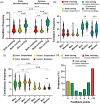Neural correlates of static and dynamic social decision-making in real-time sibling interactions
- PMID: 39031478
- PMCID: PMC11258888
- DOI: 10.1002/hbm.26788
Neural correlates of static and dynamic social decision-making in real-time sibling interactions
Abstract
In traditional game theory tasks, social decision-making is centered on the prediction of the intentions (i.e., mentalizing) of strangers or manipulated responses. In contrast, real-life scenarios often involve familiar individuals in dynamic environments. Further research is needed to explore neural correlates of social decision-making with changes in the available information and environmental settings. This study collected fMRI hyperscanning data (N = 100, 46 same-sex pairs were analyzed) to investigate sibling pairs engaging in an iterated Chicken Game task within a competitive context, including two decision-making phases. In the static phase, participants chose between turning (cooperate) and continuing (defect) in a fixed time window. Participants could estimate the probability of different events based on their priors (previous outcomes and representation of other's intentions) and report their decision plan. The dynamic phase mirrored real-world interactions in which information is continuously changing (replicated within a virtual environment). Individuals had to simultaneously update their beliefs, monitor the actions of the other, and adjust their decisions. Our findings revealed substantial choice consistency between the two phases and evidence for shared neural correlates in mentalizing-related brain regions, including the prefrontal cortex, temporoparietal junction (TPJ), and precuneus. Specific neural correlates were associated with each phase; increased activation of areas associated with action planning and outcome evaluation were found in the static compared with the dynamic phase. Using the opposite contrast, dynamic decision-making showed higher activation in regions related to predicting and monitoring other's actions, including the anterior cingulate cortex and insula. Cooperation (turning), compared with defection (continuing), showed increased activation in mentalizing-related regions only in the static phase, while defection, relative to cooperation, exhibited higher activation in areas associated with conflict monitoring and risk processing in the dynamic phase. Men were less cooperative and had greater TPJ activation. Sibling competitive relationship did not predict competitive behavior but showed a tendency to predict brain activity during dynamic decision-making. Only individual brain activation results are included here, and no interbrain analyses are reported. These neural correlates emphasize the significance of considering varying levels of information available and environmental settings when delving into the intricacies of mentalizing during social decision-making among familiar individuals.
Keywords: fMRI; hyperscanning; mentalizing; siblings; social decision‐making; social interaction; theory of mind.
© 2024 The Author(s). Human Brain Mapping published by Wiley Periodicals LLC.
Conflict of interest statement
The authors declare that they have no known competing financial interests or personal relationships that could have appeared to influence the work reported in this article.
Figures





References
MeSH terms
LinkOut - more resources
Full Text Sources
Medical

